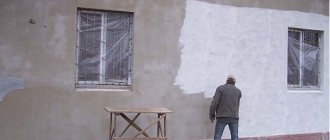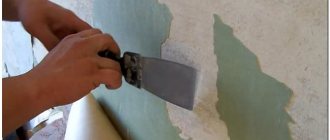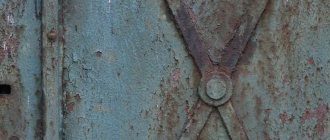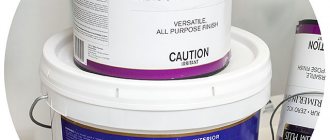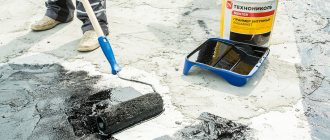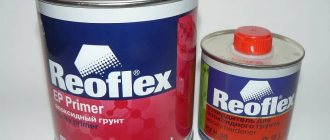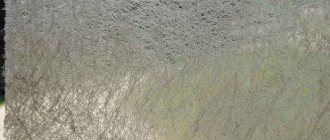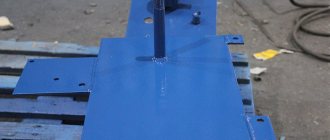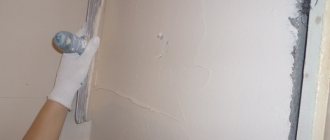When carrying out work such as painting or puttying walls, you cannot do without a primer. Such preparation will help improve the condition of the surface and can significantly reduce the consumption of paints and varnishes. For priming, various compositions are used, intended either only for plastered walls, or for wood or metal. But there are also universal materials, such as latex primer.
The latex-based primer deeply penetrates the surface and is ideal for any room. It’s easy to learn how to work with it and you don’t need to have experience as a finisher to do it.
Purpose and application
Latex primer is used for treating exterior and interior spaces. Can be used for wood processing. The mixture works well on old, christened and untreated wood.
When treating a concrete surface, it is best to lay a layer of primer on top of the recently hardened mixture. The solution acts on concrete in such a way that it penetrates the pores and prevents crumbling. The latex solution acts similarly when applied to plaster.
Important! Latex primer is an integral part when processing metal surfaces. This mixture will prevent rust from occurring.
Acrylic and latex primer - what is the difference?
Many people wonder which primer is better - latex or acrylic? It would seem that both materials are intended for preparatory work when processing bases. But you can decide which one to choose only by studying the manufacturer’s instructions.
When choosing, you should take into account that the difference between these two materials is that acrylic will not protect against corrosion, while latex will provide this protection. In addition, the latter can still be used in damp areas. The materials also differ in composition.
Advice! If you have any doubts when choosing, it is recommended to contact a sales consultant and find out exactly how one and another product differs.
Composition and technical characteristics
The latex-based primer contains the following components:
- drying accelerators;
- styrene acrylic latex;
- pigments;
- defoaming agents;
- oils;
- preservatives;
- antiseptic.
The list of composition can be expanded depending on the production technology of a particular product.
Water is used as a diluent for all formulations. There are primers that do not require thinning. The proportions for dilution are used individually by each manufacturer. The situation is similar with other characteristics and application features: drying time, density, application temperature, shelf life, suitable material.
Consumption per 1 m2
Consumption per square meter depends only on the composition used. To calculate the approximate amount of the required substance, special calculators are used. But they do not give an exact number, since the calculation is strictly approximate. It is not the specific characteristics of the material being processed that greatly influence the amount of solution required. Most types of latex mortar have a consumption of about 80-120g/m2.
Other types
Of course, such a popular and necessary means for finishing rooms and facades has many types. Among other types of primers, the following can be distinguished:
- Mineral, the main component of which is cement. The main purpose of such a primer mixture is to eliminate unevenness and carry out processing as quickly as possible.
- Glypthal - used as temporary protection for metal.
- Perchlorovinyl - characterized by the ability to dry quickly - no more than an hour. Due to their high toxicity, such compositions can only be used outdoors.
- Phenolic - the main component is carbolic acid and anti-corrosion pigment.
- Polyurethane – used as floor primers for tiles.
Griftal primer for metal and wood
Tips and recommendations for use
Regardless of whether the composition needs to be diluted or not, the mixture must be stirred. This will allow the particles settled below to be evenly distributed in the composition.
The operation of the latex primer is simple. To do this, you must act according to the compiled algorithm:
- Prepare the surface for applying the mixture. To do this, all stains on the base, rust, fungus and other contaminants are removed. Afterwards, cracks, cracks and unevenness are sealed using putty.
- Dilute the soil in accordance with the ratio indicated on the package (each manufacturer makes its own composition, so the proportions may differ).
- Treat the surface with a primer using a roller, brush or spray. During this procedure, the temperature during application must exceed 10 degrees Celsius, and the air humidity must be more than 75%. Such parameters are necessary for high-quality and rapid hardening of the mixture.
- Wash the instruments from the composition.
Important! Paint or glue can be applied to the prepared surface only after the mixture has dried, as evidenced by the formation of a polymer film. If you start the painting or pasting procedure earlier, the quality of the work will be at a low level.
The primer technology itself consists of three stages:
- The primer mixture is poured into a tray or other small container.
- Hard-to-reach places are treated with a brush. Window slopes and doorways are processed especially carefully.
- The remaining surfaces are processed using a roller. After each dipping of the roller, it must be squeezed out of excess mixture.
To achieve a strong layer of primer, the procedure must be carried out twice. In this case, the surface will be maximally saturated with the composition. The wall must be allowed to dry between coats.
Surface preparation
Before priming, it is necessary to perform a number of preparatory work, namely:
- Follow all safety measures. When working at height, you need to prepare a strong structure, this can be special scaffolding or self-made scaffolding. Be sure to wear protective clothing, closed shoes, safety glasses and a hat. It is not recommended to perform work if you are not feeling well. Only with a good frame of mind can you properly prime the surface.
- Prepare all the necessary materials and tools: rollers, brushes, pallets, containers for primer, polyethylene, newspapers, rags.
- To prepare the base: you should carefully remove rust (from metal) or mold (from walls) with a brush, wash greasy stains with detergents, and, if necessary, treat the walls with antiseptics to prevent rotting. Next, the surface needs to be given time to dry.
- Cracks should be expanded and treated with plaster mortar or a specialized mixture.
- All furniture and floors in the room must be covered with polyethylene. Even if a water-based primer is used, once it gets on any surface, stains will be difficult to remove.
- It is important to monitor the temperature and humidity conditions. The temperature must be at least 10 degrees, and the humidity must be at least 75%.
Advantages and disadvantages
Advantages of latex-based primer:
- safe for people and animals, there are no harmful emissions that are characteristic of other types of primer;
- dries quickly;
- low cost of the mixture;
- the treated surface becomes resistant to moisture;
- prevents the occurrence of rot and mold;
- increasing the adhesion of the material to the paint;
- resistance to low temperatures.
This primer can even be applied to old paint or a surface that has not been prepared. And thanks to the wide selection, the buyer will be able to choose the color scheme that he requires.
Disadvantages of latex-based primers:
- high consumption of concentrated substance;
- does not have full characteristics for individual types of coating, since the composition is developed for all types of materials at once;
- the solution must be prepared in strict accordance with the proportions.
Often, latex primer is used as a coating preparation for parquet varnish, enamels, oil paints, plaster and marble chips.
Application in repair
The scope of application of latex primers is quite extensive and they can be used for working with indoor surfaces, carrying out facade and street repair and finishing work.
Latex-based primers can be used to treat untreated and painted wooden surfaces; they can also be used with old wood that has been exposed to open conditions for a significant period of time.
Latex primer mixtures can be used on wood bases, but if you have to work with an untreated wood base that releases resinous substances, it is better to choose an alkyd solution for priming.
We use latex primer for the preliminary preparation of cement, concrete and plastered surfaces. The solution will penetrate into the pores of the base as deeply as possible and qualitatively strengthen it from the inside, thereby preventing the unwanted process of shedding. Since the material dries quickly, it is ideal for use where “fresh” surfaces need to be quickly prepared for painting or cladding.
[su_note note_color=»#f1f1f1" text_color=»#3d5d82" radius=»1"]
Recommended reading:
Latex-based solutions are also suitable for working with metal surfaces: using primer will help protect the base from corrosion processes and rust.
Since latex primers are universal, they are suitable for treating all types of premises. This quality of primer mixtures helps to save not only on the consumption of finishing materials, but also on the purchase of the composition itself: there is no need to purchase a separate solution for each surface.
Types and properties of latex primer
There are latex primers that are ready to use immediately and those that need to be prepared before work. Therefore, before starting priming, you must carefully read the instructions included with the product.
Latex primers differ from each other in several ways:
- surface for application;
- hardening time;
- density.
Depending on its purpose, the latex mixture is suitable for processing:
- aluminum;
- concrete;
- drywall;
- wood;
- bricks;
- plastered and putty surfaces.
The latex primer shows excellent results on porous surfaces such as drywall or concrete, due to its deep penetration property. The solution works similarly with a wooden base. All pores in loose and uneven surfaces will be protected by the penetrating compound.
Application of primer mixtures
Following the technology of finishing work associated with the need to prime surfaces, before applying paint you need to:
- be sure to prepare the surface by cleaning it from old paint, traces of dirt, dust, and various stains;
- level and repair damaged areas if the surface is covered with cracks, dents and other types of defects;
- Allow the base to dry after preparatory work.
During surface preparation, a metal scraper and sandpaper can be used to remove flaking and loose old paint. Stains can be removed by washing the contaminated areas with water and detergent. Oily, greasy stains are treated using white spirit and other solvents.
When cleaning surfaces, it is worth changing rags more often.
Primer mixtures are sold ready to use. In cases where the solution needs to be prepared in any way before use, proceed according to the instructions included with the product.
In any case, the primer mixture should be thoroughly mixed before use. This is done so that the particles that settle to the bottom are evenly distributed inside the composition.
Primer mixtures are applied to the surface depending on its area using a roller or spray gun or airbrush. Which primer is better, acrylic or latex? So that the composition can be sprayed with a spray gun, it is diluted to the required thickness.
To increase the quality of the film formed when the soil dries, it is applied in two or even three layers. The consumption of deep penetration primer mixture depends on the porosity and area of the surface being treated, and the number of layers of soil.
Each new layer of primer is applied only after the previous one has completely dried.
Advantages of a universal latex primer
Latex primer was originally created so that it could be used on almost any combination of surface and applied material. The main distinguishing feature of the mixture is the depth of penetration, which ranges from 5 to 10 centimeters.
A latex-based product will only emit water vapor when applied to the surface. Unlike alternative options, which can release harmful and toxic substances in small quantities, latex primer is completely free of this disadvantage. It is safe for children, adults and animals, therefore it is used in residential areas.
The composition completely ignores the effects of moisture. This property allows it to be used in rooms with high humidity, such as a bathroom or kitchen. To this property is added resistance to low temperatures. Taken together, these parameters make it possible to use latex mortar when finishing facades.
Fungus will not be able to form on the treated surface due to clogging of all holes. The latex-based composition is “liquid rubber”, which fills all the pores on the surface.
Fast-acting formulations will create a film in half an hour. Thanks to this, interruptions during construction will be minimal.
Quartz
Quartz primer, unlike most other types of this material, significantly improves the adhesion of the surface of the walls and the coating to each other. The composition of quartz primer includes the following components:
- acrylic or latex component, which contribute to better retention of the material on the surface;
- bactericidal substances designed to ensure durability even at high humidity;
- emulsifiers that improve the effectiveness of the primer;
- coloring pigments.
Quartz primer with mineral sand
The quartz mixture is simply irreplaceable for further laying of tiles. When working with this primer, you need to pay attention to the following points:
- The material contains acrylic and mineral sand, which means it takes a long time to dry, so humidity may increase in the treated areas.
- When working with such a primer, it is better not to use a spray bottle, otherwise you can clog the equipment holes with sand.
- This primer mixture is consumed significantly more than conventional compositions. This is caused by the functional purpose of the material - to increase surface adhesion.
- Wall treatment can be carried out in one layer, since the composition does not contain volatile substances.
Review of popular manufacturers
The building materials market is filled with various latex primer offers. The most popular products are:
- "Text Pro Moisture Protection" from domestic. Designed for processing concrete, plasterboard and plastered surfaces. Density is 1000 g/l. Used for interior work.
- "Optium" from domestic. The composition has a density index from 1000 to 1100 g/l. Before application it is diluted with water. The dry residue is 5%. Used for interior work. Under suitable conditions, it hardens in 40 minutes.
- Domestic latex primer. Suitable for concrete, tiles, wallpaper and paint. The curing period is 60 minutes.
- "Seal Grip" from domestic. Suitable for processing concrete, plasterboard, glass, plastic, wood, aluminum, plastered and galvanized surfaces. The amount of dry residue is 2%. Used for interior work. Under comfortable conditions, it hardens in 60 minutes.
- "Sniezka" from the Polish manufacturer of the same name. Designed for processing concrete, metal and wood. Diluted with water. In the dry residue the amount of substance is 5%. Used for interior work. The composition will take 2 hours to dry.
Latex primer allows you to create high adhesion to almost any surface and finishing material. This is one of the best ways to prepare the surface for further work, because the composition penetrates into all cracks, filling them. The mixture will protect the wall from moisture, the consequences of its exposure and other environmental factors.
Advice from the experts
Professional painters advise:
- Apply paint to the primer layer only after it has completely dried.
- The primer should also be applied only to a dried surface.
- If the solution gets on the skin of your hands or eyes, it should be washed off immediately with water.
- Carry out painting work only with protective glasses and gloves.
- Wash tools used for applying primers thoroughly immediately after use.
- Keep all formulations out of the reach of children.
- The surface should be primed immediately, without interruptions, since these primers are quick-drying.
In addition to the fact that latex and acrylic-based primers create an excellent substrate for paint, they are excellent fillers for microcracks. Thanks to the ability of universal primers to penetrate deeply into the pores of heterogeneous and loose surfaces, additional mechanical protection is provided to their paint coating. Primers have a property that paints do not have - good fillability.
The fact that acrylic and latex-based primer mixtures are easy to use, do not require special storage conditions, and dry quickly has made them popular and in demand among a wide range of consumers.
Similar
Prime the walls using a deep penetration primer. How to prime walls? This video is about primed.
All about primers and priming. We reveal the secrets of primers with Weber technical specialist Alexander. Razbe.
Types of paints. Which ones are for ceilings, which ones are for walls. Emulsion, dispersion, acrylic, latex, etc.
Subscribe to our channel: https://goo.gl/wStR9X Review on Silicone Primer -
Acrylic primer vs.
- strength and durability of the resulting polymer layer;
- rich colors that do not lose brightness over time;
- stability under the influence of ultraviolet radiation from the sun;
- water base, which ensures the non-toxicity of the color mixture and the absence of unpleasant odors during operation.
- Apply paint to the primer layer only after it has completely dried.
- The primer should also be applied only to a dried surface.
- If the solution gets on the skin of your hands or eyes, it should be washed off immediately with water.
- Carry out painting work only with protective glasses and gloves.
- Wash tools used for applying primers thoroughly immediately after use.
- Keep all formulations out of the reach of children.
- The surface should be primed immediately, without interruptions, since these primers are quick-drying.
An important condition for the use of acrylic primers is their environmental safety. The manufacturer creates a solution that is water-based or contains a small percentage of solvent. Thanks to this, you can prime the rooms inside the house and not worry about the presence of an unpleasant odor.
When using solvent-soluble mixtures, you should remember their toxicity, for which it is necessary to use primers for street work. To buy good soil, you need to pay attention to the following nuances:
"Tikkurila" is a very well-known Finnish company in Europe, engaged in the production of paints and varnishes on various bases, including those based on latexes. The company opened the first plant for the production of paints and varnishes back in 1919. The first water-based interior paint , “Joker,” was produced by the company in 1953, and what’s interesting is that this composition is still produced under the same name.
- As we have already learned, acrylic and latex paints are resistant to water, however, the painting surface is not protected from fungus. Which primer is best for walls for painting with water-based paint? Therefore, before applying paint to the surface, a process of applying a primer (a special treatment on the wall to give the surface special properties) must go through.
- Low temperatures have a detrimental effect on painting, so these types of paints are suitable only in well-heated rooms. However, acrylic paints cope better with low temperatures. This applies more to latex paints.
- Good resistance to moisture does not exclude the appearance of fungus on the painted surface. To eliminate this drawback, it is enough to treat the walls with a primer.
- Low temperatures have a detrimental effect on paints, but this disadvantage is least evident in acrylic paints and is absent in such a variety as façade.
During renovation and construction work, in addition to leveling and painting walls or wallpapering, builders recommend priming. Today you can find a large number of products that are used only for metal, plaster, wood or concrete bases, but latex primer is also produced, which is a universal building material.
Soil "Lakhta"
Latex primer “Lakhta” is a one-component emulsion that has a milky white color. The soil can be used both in diluted and concentrated form. The proportions of dilution directly depend on the nature of the surface being treated and the purpose of the work. This primer can be used to treat the following substrates: concrete, iron, gas and foam concrete, brick, gypsum stone, wood.
Builders note the following advantages of the material:
- Reduced ability of the base to absorb moisture from the environment.
- Strengthening the surface of the material.
- Improving the adhesion of waterproofing, repair and finishing materials to the base.
Grida soil
Deep penetration latex primer with acrylic “Grid” is used to strengthen substrates with a high degree of absorption and to prepare the surface for the application of finishing or decorative materials. According to consumer reviews, the Grid priming solution reduces the consumption of finishing coatings and improves adhesion.
The primer can be applied to the following substrates: brick, plastered surfaces, plasterboard, wood, cement, concrete, etc. Advantages of the “Grid” priming solution:
- The primer has an antiseptic effect.
- The consumable material is used for external and internal work.
- The primer is excellent for treating different types of surfaces.
- The emulsion is environmentally safe for human health and the environment.
Ease of use, versatility, and the ability to dry quickly make latex primer in demand among ordinary consumers and professional builders. However, it should be remembered that when working with soil, you must follow both the instructions for its use and the priming technology.
It is difficult to imagine a modern renovation in which there is no place for primers. Professional finishers will have a negative attitude towards the issue of reducing costs associated with not using this material. First of all, because its main effect is to change the properties of the surface for the better.
- 1 Types of primers
- 1.1 Acrylic
- 1.2 Alkyd
- 1.3 Others
- 2 Universal latex-based primers
- 2.1 Advantages of the material
- 2.2 Application of latex primer
- 2.3 Professional advice
- 3 Conclusion
- significantly increase adhesion between layers of different materials;
- protect treated surfaces from moisture penetration;
- change their structure, making it impossible for pathogens to develop.
Pictured is a universal latex-based primer.
Thanks to a variety of primer compositions it is possible to:
These characteristics of primers determine their widespread use in the construction and repair process. For example, professionals apply them wherever they want to get a high-quality result that will last for a long time.
In modern construction and renovation, three main types of primer compositions are used:
- antifungal (antiseptic);
- universal (deep penetration);
- concrete contact.
Advice: if you are undecided whether latex or acrylic primer is suitable for you, choose according to the substrate, although they are almost identical.
Odorless acrylic latex primer

